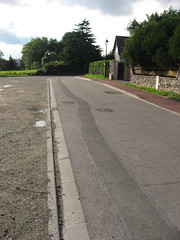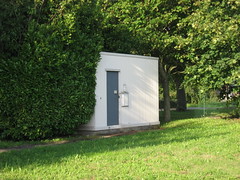I met up with Jean LEBRET of
Yvelines Numériques today in Paris. (For a quick reminder: Yvelines Numeriques is a public/private backhaul network running through our French
department). We walked over to a small cafe to talk about the project when French fighter planes cruised right above us in formation - flanking what looked to be a bomber of some sort. It happened three times on the short walk and the jets even left blue and red trails behind them. The whole ground shook as they flew by. Very impressive. We assumed it was practice for Bastille Day coming up.
Once we sat down I explained what I wanted to accomplish with the project and where our residence is located. I may be wrong but I think he was a bit surprised with my determination to see this project through. He jumped right in too saying that he hadn't heard of a similar project yet in France and thought this could actually work in our favor - helping us convince politicians to help me out.
He pulled out his computer and we started going over the maps. It turns out we are very close to their fiber backbone network - but not quite as close as their public map had made it appear. Their network actually dips down a street lower from us, away from the main road, as it comes near the church (and near us). He was able to measure the distance from the edge of the residence to the nearest possible splice point for their network (310 meters). Still not too bad.
He gave me an estimate for how much it will cost to get from our network (in the residence) to his (closer to the exchange): EUR 120 per meter.
310 meters * EUR 120/meter = EUR 37,200
Expensive. He did mention that the prices for the dig could actually be lower (down to EUR 50 per meter) if we were mainly going through fields - which I don't think we would be.
I was a bit taken back with the costs of simply getting to the backhaul but it make me think of some other options, particularly wireless. I'll write about those a bit later.
The main thing I pulled out of our conversation was that he thinks the best way to approach this is by convincing the government to help us get connected to the network. We would essentially ask the village or department to pay for (or subsidize) the connection to Yvelines Numériques as a way for them to save money on connectivity for government offices in the town (e.g. schools, mayor's office, post office). The more he talked about it the more I thought this could be an option. He gave me the names of two people in the Conseil Général to contact who may be able to help. He also suggested I go back to the Mayor and try to convince him to pool the demand for the local government as a way to justify running a fiber between the mayor's office and their network. We could take some strands as the network passed by on the road to the commercial center.
This could be
politically attractive option since the Department helped fund half the backbone network and they would have an interest in seeing it lit. Yvelines Numériques only provides the dark fiber so the more cables they can light, the better. I got the impression that the network has much more capacity now than is in use. Out of the 144 fibers in their first cable it sounded like less than 10% were lit in our area. They would definitely have room for us if we could get to them. He also explained that once we'd be in contact with their own fiber the costs would be quite low to go the rest of the way to the exchange (100 meters). They charge EUR 1.80 per meter per year.
Once we made it to the exchange other operators could easily supply us with services since they also have lit fibers on the same backhaul network. The operators may not have their own equipment in the exchange now but it wouldn't be difficult or expensive to simply create a drop point.
Finally, Jean recommended I use PEHD (high density polyethylene in English) for the conduit when I lay it down in the sidewalks. By his calculation I'd need around a kilometer of it and he said the costs wouldn't be too bad.
I was very glad that Yvelines Numériques got back to me and there may be a way to work with them on this. The costs seemed high but I feel at least that this was sign that I can actually make this work.

